Fossil Footprints Reflect Diverse Dinosaurs in South-western Alaska
Dinosaur fossils and their footprints have been found in Cretaceous-aged rocks in the American state of Alaska before. Everything Dinosaur has produced a number of articles featuring fossil discoveries, many of which come from the Denali National Park area of the central part of the state. However, a new paper published in the journal PLOS One, provides an insight into the dinosaurs that roamed the south-western corner of the “Last Frontier” state.
The Late Cretaceous of the area of Alaska now known as the Aniakchak National Monument was dominated by duck-billed dinosaurs, but ankylosaurs, theropods and birds also lived in that part of the world.
A Digital Reconstruction of the Aniakchak National Monument in the Late Cretaceous
Picture credit: Karen Carr/PLOS One
The Late Cretaceous (Maastrichtian) Chignik Formation
The trackways, individual prints and other fossils, such as cycad leaves that indicate that around 70 million years ago, this part of Alaska was much warmer than it is today, provide palaeontologists with an insight into a high latitude, dinosaur dominated ecosystem. These fossils may also provide some further evidence to help palaeontologists understand how dinosaurs migrated from Asia into the Americas. Seventy-five new dinosaur footprints and trackways have been documented, more than ninety percent of which represent hadrosaurs.
Representative Hadrosaur Tracks
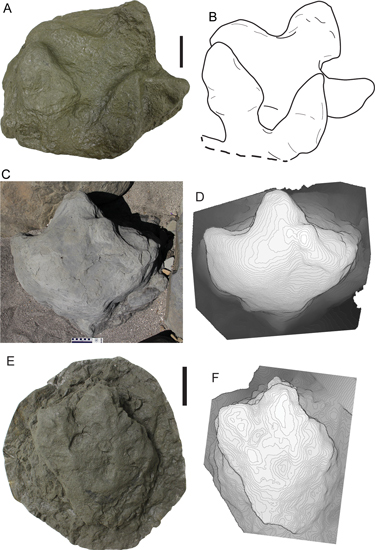
Picture credit: PLOS One
Fossil Footprints
Co-author of the study, Dr Yoshitsugu Kobayashi (Hokkaido University Museum, Japan), stated:
“This study provides us a better understanding of the high-latitude dinosaur ecosystems of Alaska. Such an understanding will help us address important questions such as did the dinosaurs survive the winters there and, if so, how did they survive?”
A Map Highlighting the Position of the Fossil Discoveries
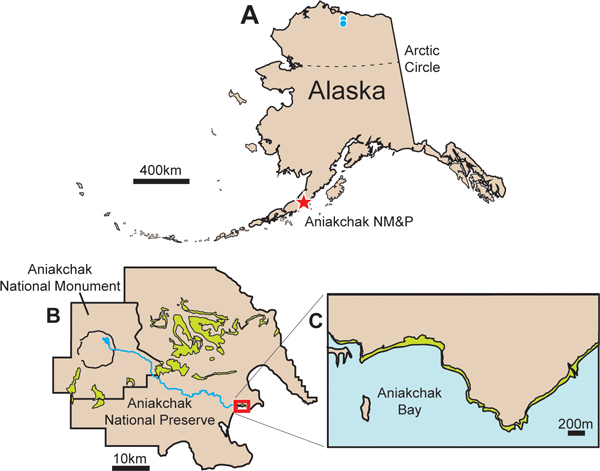
Picture credit: PLOS One
Ankylosaurs Present Too
Two tracks have been identified as having been made by armoured dinosaurs (ichnotaxon Tetrapodosaurus), both these tracks were found in fallen blocks and the largest of the footprints measures around 35 centimetres wide. The impression of five digits in each of the tracks indicate that these prints represent tracks made by the forelimbs, not the four-toed back legs of armoured dinosaurs.
A Potential Ankylosaur Track – Aniakchak National Monument
Picture Credit: PLOS One with additional annotation by Everything Dinosaur
Avian and Non-avian Theropods
The research team also identified a number of different sized tridactyl (three-toed), prints. Two different types of bird track were identified in the study, along with a much larger single print that the scientists estimate was made by a theropod dinosaur around five to six metres in length. The fossil print has been assigned to the ichnogenus Grallator. The track suggests a large, predatory dinosaur and the team comment that the footprint is roughly around the track size that would have been made by the pygmy tyrannosaurid Nanuqusaurus hoglandi, which was named and described in 2014, from material found in the far north of Alaska (Prince Creek Formation).
A Large Three-toed Theropod Dinosaur Print (Aniakchak National Monument)
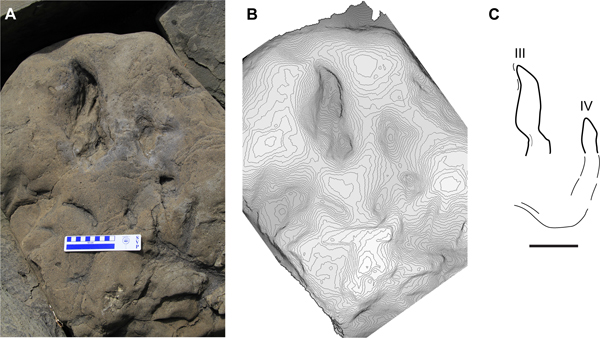
Picture credit: PLOS One
The scientific paper: “Dinosaur ichnology and sedimentology of the Chignik Formation (Upper Cretaceous), Aniakchak National Monument, south-western Alaska; Further insights on habitat preferences of high-latitude hadrosaurs)” by Anthony R. Fiorillo, Yoshitsugu Kobayashi, Paul J. McCarthy, Tomonori Tanaka, Ronald S. Tykoski, Yuong-Nam Lee, Ryuji Takasaki and Junki Yoshida published in the journal PLOS One.
Everything Dinosaur acknowledges the assistance of a press release from the Perot Museum of Nature and Science in the compilation of this article.
The Everything Dinosaur website: Everything Dinosaur.


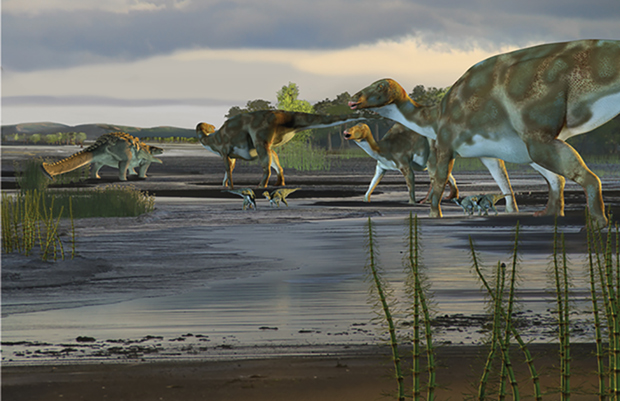
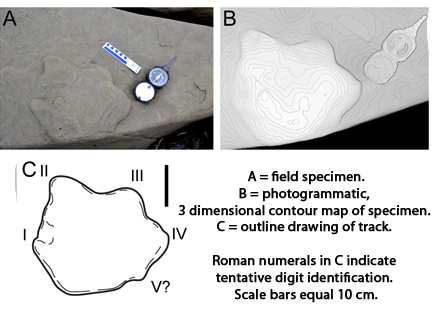




Leave A Comment